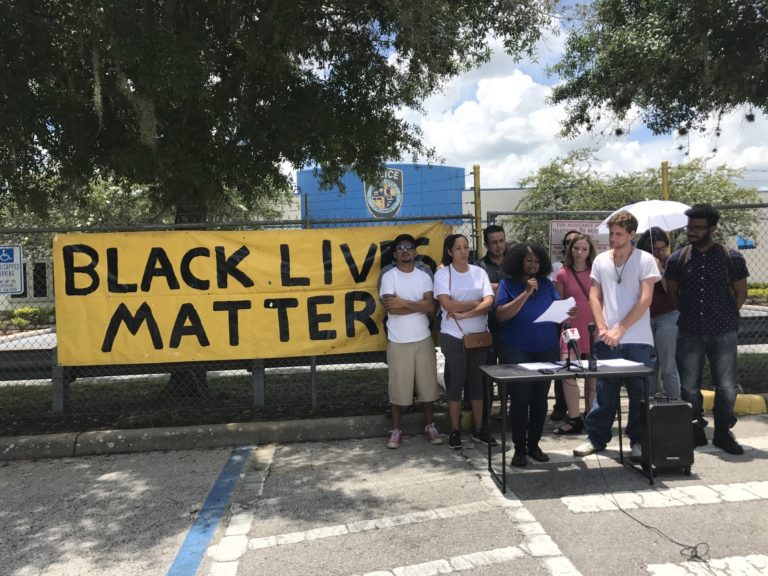
Activists and family members presented a list of demands at the Plant City Police Department Saturday after the fatal police shooting of Jesus Cervantes.
Black Lives Matter Tampa along with other activist groups presented a list of demands for the Plant City Police Department following the fatal police shooting of Jesus Cervantes.
The groups were joined by members of Cervantes’ family, who said they simply wanted justice for Cervantes. Showing Up for Racial Justice Tampa, ANSWER Suncoast and the Restorative Justice Coalition united with Black Lives Matter Tampa to solidify the demands that were presented at the police department.
“This protest is being held because Florida Justice Coalition along with our partner organizations are fed

up with the nationwide tragedies that are occurring at the hand of the state, so we want to go ahead and make demands of our Plant City Police Department and correct it,” Angel D’Angelo, a co-organizer of the event, said.
Cervantes was killed on July 6 after leading police on a high-speed chase. The car, driven by Cervantes, attempted to run officers off the road and a chase ensued. He eventually lost control of the vehicle after running over stop sticks and crashed into a ditch in front of a BP gas station.
Officers surrounded the vehicle and Cervantes failed to obey their commands and “he went into the driver’s side rear door for an unknown object,” according to PCPD.
Officers Gerald Baker and Derek Hartmann shot Cervantes, and he died at the scene.
Because the department does not have body or dash cameras, there is no police-recorded video of what transpired. Security footage from the BP gas station was pulled and sent to the Florida Department of Law Enforcement for investigation, according to Sgt. Alfred Van Duyne.
The cost of having a force with body cameras goes far beyond simply purchasing the equipment. While the cameras themselves aren’t cheap — they range in price from $300 to $800 per officer — the storage is the true hurdle for department’s budgets. Depending on the storage model and size, costs have been found to be approximately $1,500 a year for each individual camera, according to the International Business Times.
The city commission approved a budget of approximately $13,000 for purchasing cameras in June 2014, but the then-new chief of police, Edward Duncan, had doubts about the viability of such a program.
Van Duyne said Duncan had far more experience than the rest of the department on the cameras and knew that the cost for an entire department was going to be far greater than what was anticipated by the city.
“He knew the real cost, like the cost of upkeep, and it becomes the department’s responsibility. You have to buy hardware and software and an archival system, and also there was a concern about the judicial process,” Van Duyne said.
Officers operate under the assumption people have a reasonable expectation of privacy, and wearing body cameras can become a complicated subject when they respond to house calls or do minor tasks like helping someone who ran out of gas, which may feature subjects who do not wish to be filmed.
According to Van Duyne, Duncan decided to wait on purchasing the cameras to see how larger departments in the area, many of whom are testing the units, fare.
Duncan did not want to have a “knee-jerk” reaction to national incidents, like what happened in Ferguson, Missouri.
“While what happened in Ferguson was tragic, we didn’t have that same volume of police-involved shootings and from what I understand from (Duncan), during that time it wasn’t something he wanted to use that large of resources to do,” Van Duyne said. “He wanted to make sure the studies are done … once he got an idea of the big picture he would reevaluate the issue.”
At the protest, the groups released an extensive list of demands, which include a federal investigation of the shooting, the installation of body and dash cameras for the department, the release of the surveillance video from the BP gas station, for the officers to undergo a variety of trainings and for the creation of an independent civilian review board.
“Some of the demands we have here are a clear way to build trust, a clear way for transparency, if they
have nothing to hide,” Ruth Beltran, an organizer for Black Lives Matter Tampa, said.
However, Van Duyne said some of the demands highlight a lack of knowledge on the issue and how the judicial system works. He said PCPD does not have the video footage from BP, as it was taken to the FDLE for their investigation.
He also said the demand for an independent investigation was also something that would not be immediately fulfilled. In all 67 counties in Florida, these incidents are investigated by the Florida Department of Law Enforcement and the State Attorney 13th Judicial Circuit. They each do independent investigations.
If their findings are reviewed and people feel they are misleading, they can then be appealed to the Department of Justice. However, Van Duyne said you can’t simply skip the process and go straight to the DOJ.
